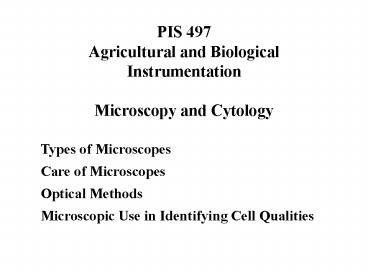PIS 497 Agricultural and Biological Instrumentation Microscopy and Cytology - PowerPoint PPT Presentation
1 / 23
Title:
PIS 497 Agricultural and Biological Instrumentation Microscopy and Cytology
Description:
Differential Interference Contrast Microscopy Photo-Microscopy ... Scanning (SEM) - an electron bean is 'scanned' across the specimen. ... – PowerPoint PPT presentation
Number of Views:52
Avg rating:3.0/5.0
Title: PIS 497 Agricultural and Biological Instrumentation Microscopy and Cytology
1
PIS 497Agricultural and Biological
InstrumentationMicroscopy and Cytology
Types of Microscopes Care of Microscopes Optical
Methods Microscopic Use in Identifying Cell
Qualities
2
Types of Microscopes
Dissecting (stereo) Light Electron
3
Dissecting Scope
4
Light Microscope
See handout for the explanation of parts.
5
Microscope Schematic
6
Optical Methods
Bright Field Microscopy Dark Field
Microscopy Phase Contrast Microscopy Fluorescence
Episcopic Microscopy Differential Interference
Contrast Microscopy Photo-Microscopy
http//nsm.fullerton.edu/skarl/EM/Microscopy/Ligh
tMicroscopy.html
7
Sample Preparation
Microtome can prepare slices about 20 ?m thick.
Slices are prepared for observation of
structure. Smears are prepared for observation of
chromosomes.
8
Microtome
9
Same Specimen with Focus at Different Heights
http//nsm.fullerton.edu/skarl/EM/Microscopy/Dept
hoffield.html
10
Fungal Endophyte in Ryegrass
11
Concepts Important for Viewing
Resolution - ability to see objects clearly Depth
of Field - depth that focus is clear Contrast
Formation - (e.g. absorption contrast) Illuminatio
n Source - diascopic vs. episcopic from below
(compound) vs. from above (dissecting)
http//nsm.fullerton.edu/skarl/EM/Microscopy/Intr
oLightMicro.html
12
How The Concepts Interact
As Resolution and Brightness improve, Depth of
Field and Contrast Formation are diminished.
Vice versa is also true. These are controlled by
the iris diaphragm.
http//nsm.fullerton.edu/skarl/EM/Microscopy/Intr
oLightMicro.html
13
Empty Magnification
The effective magnification on an objective lens
is 1000 x its numerical aperture. If a 40 x
objective has an numerical aperture of 0.65, it
has an effective magnification of 650 x.
Magnification beyond 650 x is called empty
magnification.
http//nsm.fullerton.edu/skarl/EM/Microscopy/Reso
lution.html
14
Resolution
The distance between two objects that is required
for the two objects to be distinguished.
http//nsm.fullerton.edu/skarl/EM/Microscopy/Reso
lution.html
15
Resolution
Actual
What We Might See
Even if we magnify an image of two objects, we
can not distinguish them unless we have adequate
resolution.
http//nsm.fullerton.edu/skarl/EM/Microscopy/Reso
lution.html
16
Resolution
The equation for calculating resolution
is Resolution (nm) ? (0.61) / Numerical
Aperature Numerical Aperture refractive index
of medium ? sin (acceptance angle / 2)
http//nsm.fullerton.edu/skarl/EM/Microscopy/Reso
lution.html
17
Resolution
For a 4 x lens, with a numerical aperture of 0.10
the resolution equals 500 nm (0.61) / 0.10
3050 nm or 3.05 ?m
http//nsm.fullerton.edu/skarl/EM/Microscopy/Reso
lution.html
18
Resolution
10 to 20 mm
?
Numerical Aperture for a 4 x lens may be 0.10 and
for a 100 x may be 1.30.
http//nsm.fullerton.edu/skarl/EM/Microscopy/Reso
lution.html
19
Contrast
Absorption (staining) contrast is usually used
with bright field microscopy. Highest contrast
achieved with black and white.
http//nsm.fullerton.edu/skarl/EM/Microscopy/Cont
rast.html
20
Contrast
Bright Field
Phase Contrast
Dark-Field
http//nsm.fullerton.edu/skarl/EM/Microscopy/Cont
rast.html
21
Electron Microscopy
Uses a beam of electrons to view topography,
morphology, composition, and crystallography. EM
was developed for 10,000 X magnification.
Properties of light limit magnification of light
microscopes to 1000 X and resolution to 0.2 ?m.
http//www.unl.edu/CMRAcfem/em.htm
22
Types of Electron Microscopes
Transmission (TEM) - designed like a light
microscope except that an electron beam is passed
through the specimen. Resolution is 0.2
nm. Scanning (SEM) - an electron bean is
scanned across the specimen.
http//www.unl.edu/CMRAcfem/em.htm
23
How an Electron Microscopes Works
A stream of electrons is accelerated toward the
specimen. This stream is confined and focused
using metal apertures and magnetic lenses into a
thin, focused, monochromatic beam. Interactions
occur inside the irradiated sample, affecting the
electron beam. These interactions and effects
are detected and transformed into an image.
http//www.unl.edu/CMRAcfem/em.htm































